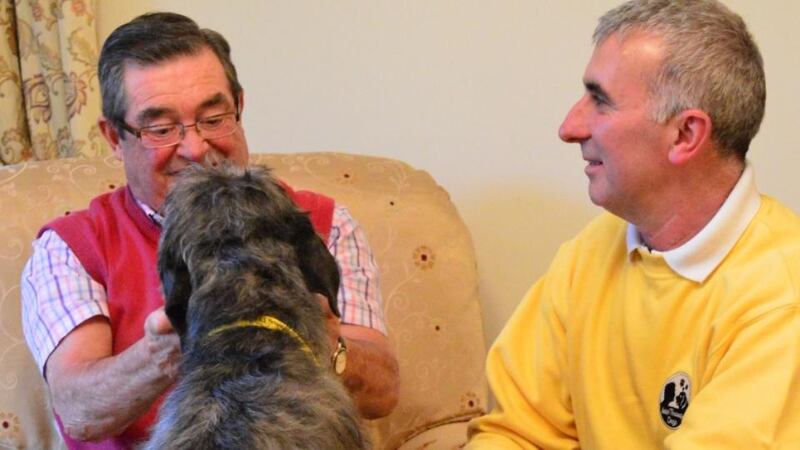Willow the cocker spaniel scrambles on to the lap of an elderly woman, and nestles in for a cuddle, her silky paws resting gently on the woman’s forearm, big brown eyes staring up lovingly. The sense of contentment and relaxation – in both human and canine – is almost palpable. It may look like a simple, everyday interaction, but in fact a minor miracle is happening here.
Because Willow is a therapy dog and, together with hundreds of other volunteer animals and their owners, she visits day care centres, hospices, hospitals, long-stay nursing and retirement homes right across the country.
For many residents, it is the high point of their week, providing comfort, stimulation, companionship and affection, as well as moments of joy and hilarity.

“They show such love, honestly, they would nearly talk to you,” says Catherine Dunleavey, director of nursing at the Tara Winthrop private clinic in Swords, which has two dogs, Sam the labradoodle and Bubbles the mongrel, visiting every week.
"These animals are really special, and the bond they have with residents is incredible. It's like they're part of the family."
Canine volunteers
Brenda Rickard, chief executive of Irish Therapy Dogs, a nationwide charity which is responsible for more than 270 canine volunteers, is passionate about the transformative impact that dogs can have on the lives of people living in institutions.
“Sometimes the results are really amazing. You can actually witness the dog increasing the person’s capacity. There was one woman who hadn’t spoken properly for three years; no one could understand what she was trying to say.
“The dog was brought in and she spoke to it as clearly as I am speaking to you right now. Every week, the dog came to visit, and she got better and better.”
At one level, stroking a dog fulfils the basic human desire to touch and be touched, a simple form of physical contact that is often lacking in the lives of people in care homes. In that sense, the benefits – easing anxiety and boosting mood – are self-evident.
It's not a new idea: Sigmund Freud, the father of psychoanalysis, believed that dogs helped his patients relax during sessions. And it has become accepted practice in many therapeutic situations; for instance, last year, following the school shootings in Sandy Hook, Connecticut, therapy dogs were brought in to provide comfort to traumatised children.
Rickard says the beneficial effects are scientifically demonstrable: “Playing with a dog increases production of serotonin and dopamine, both of which help to calm and relax us.
“Another measurable positive effect is lowered blood pressure. Frequently, a dog-owner’s triglyceride and cholesterol levels, which are indicators of heart disease, are lower too.”
Strict code of conduct
Of course, it's not just a case of bringing any dog (or indeed any owner) into the care setting.
As Rickard points out, acceptance into Irish Therapy Dogs is governed by a strict code of conduct, for both humans and pets.
Before making their fist visit, all volunteers must successfully complete a rigorous application process, including Garda clearance, submission of two references and an interview.
As for the dogs themselves, they must demonstrate that they are obedient, good natured, clean and well groomed.
“We want to see a dog that interacts well, not too lively but not too docile either,” says Rickard. “The ideal balance is somewhere between the two.”
For the volunteers, the rewards are tremendous. “You see the saddest, most vacant face, and then the dog comes into the room, and it’s as though a little lightbulb comes on,” says Rickard, who is actively seeking new volunteers, due to demand for the service.
“For the owner, that’s both joyous and humbling.”
Says Catherine Dunleavy, “A lot of people were reared with dogs, so having them come into the clinic brings it all back. Bubbles is a small dog, so he goes to the older people, a lot of whom have dementia, and sits on their knees.
“They love it, they always have treats for him. We have one lady, who’s 98 and absolutely besotted by Bubbles. Sam, the labradoodle, is a bigger animal, and he works with the younger people with disabilities.
“He loves to stand up on his back legs and give them a kiss. Both dogs are very patient, very gentle. They bring a really homely side to the clinic.”
While dogs are the most common animals used in a therapeutic care setting, it’s not unheard of for other creatures to offer their own special form of comfort.
Devotees of equine therapy say that interacting with horses can help heal depression, anxiety, anger issues and trauma. Karl Hamilton, who runs the Belfast-based environmental education service Ecomantella, uses owls, rabbits, hedgehogs, chinchillas and even snakes as therapy animals.
“With children who have autism or ADHD, their focus is improved simply by having the animals there. It’s a sensory, tactile experience for them, and we notice that it relaxes their parents too.
“We often find that autistic children can ‘read’ the animals a lot better than the average person. They often notice little quirks of behaviour that other people wouldn’t.”
Therapeutic snakes
Surprisingly, Hamilton says that snakes, especially the constrictors, are particularly useful for therapeutic purposes. "They have this strong, muscular grip that really relaxes you and calms you down. It's like getting a massage for free."
It’s clear that animals have a unique capacity to connect with human beings and help them heal, in a way that is as profound as it is simple.
As Brenda Rickard remarks, “a warm soul with a beating heart eases our sense of isolation and loneliness”.
irishtherapydogs.ie
ecomantella.co.uk








